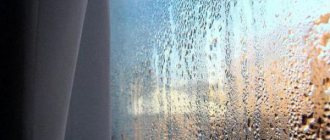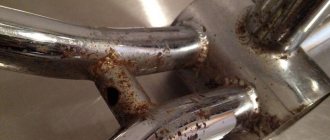High indoor air humidity is the main cause of mold development.
Molds spoil things and the environment, and also pose a danger to humans, as they increase the risk of allergies and respiratory pathologies.
A set of measures will help remove dampness, and preventive measures will help maintain the humidity level at normal levels.
For more information on how to remove humidity in an apartment, room or house, read the article.
Causes of the problem
Constantly high humidity in the room must have a specific reason. In some cases, the source of moisture can be determined quickly.
This may be an external defect during the construction of the facility or one that arose during operation as a result of wear and tear of structural elements:
- leaking roof;
- violation of the integrity of the outer wall, the tightness of the slabs;
- flooding;
- ventilation system defect.
Internal reasons for the appearance of high humidity include violation of operating rules:
- the location of several aquariums or other open containers with water in a room that is not designed for this;
- growing tropical or other plants that require abundant watering in large quantities;
- frequent drying of large amounts of laundry;
- cooking food in open pans;
- lack of sealing of windows;
- leaks in pipes (sewage, water supply, heating).
If a source of high humidity is identified, it should be eliminated.
Failure of double glazed windows
Like ventilation systems, window structures fail over time. This is especially true for seals installed on the inside of the frame. The degree of protection that a double-glazed window provides largely depends on it. In this case, the reason why the apartment is very humid can be explained by the natural wear and tear of the seal. To check its current status you need to:
- Open window;
- Press the rubber seal with your finger.
If the compacting layer quickly returned to its original position, it means it is still performing its working functions. If the rubber retains a dent or does not bend at all under pressure, it’s time to change it.
Solution to the problem : replace the glass seal (by contacting a specialist in the appropriate direction).
Determining the level of dampness in a room without instruments
A normal humidity level is considered to be between 40 and 60%. A hygrometer can be used to determine the exact level of air humidity. But even without it it is possible to draw conclusions about the humidity in the room. The easiest way is to use a glass of water.
Procedure for conducting the experiment:
- Pour water into a regular glass glass with transparent walls.
- Place the glass in the refrigerator, bringing the temperature of the liquid to +5°C. Water at room temperature can reach this value in a few hours.
- Take the glass out of the refrigerator and place it in the room. At the same time, it is necessary to control that it is not directly affected by heat from radiators, stoves with food being prepared and other appliances.
- If, after fogging, the walls of the glass dry out in just a quarter of an hour, this indicates low humidity. If after fogging the walls do not dry out, but drops begin to form and flow down, the humidity is high. In the case when the condensate that appears does not quickly evaporate, but does not drain, the humidity in the room is normal.
Another way to determine humidity is to bring a spruce or pine cone into the house and observe how the scales behave. When placed in a room with dry air, they will begin to dry out and open. If the air is damp, they will close together.
High humidity can be indicated by:
- fogging of windows in the house;
- clothes that take a long time to dry after washing;
- slow drying of floors after washing.
Such tests have low accuracy and do not provide specific numbers.
Why is air humidity increased?
Let's not talk about the most obvious reason: leakage. If your roof is leaking, then you probably noticed it yourself (at least by the buckets on the floor).
If everything is in order with the roof, then there are only two main reasons for excessive moisture:
Thermal balance is disturbed
Surely you have at least once seen condensation on the windows - droplets of moisture. Such windows are called “crying” or they say more prosaically: “the windows are fogged up.” What makes windows cry?
Condensation is associated with such a physical concept as dew point. Dew point is the temperature at which water vapor in the air turns into water and eventually falls out as condensation.
The dew point depends on the temperature and humidity in the room. The colder and drier the temperature, the lower the dew point temperature. And vice versa: the warmer the air and the higher the humidity, the higher the dew point.
Dew point determination
For example, if the air in a room is heated to a temperature of 25°C and its humidity is 65%, then the dew point will be 17.5. This means that condensation will form on any surface whose temperature is equal to or below 17.5°C. If it is a winter day with an air temperature of -15°C, then it is likely that your window glass will cool to the dew point of 17.5°C and “cry”.
Likewise, condensation can form in a corner near a window or on a wall—wherever the temperature corresponds to the dew point. Condensation on the walls sooner or later turns into fungus and mold. If the wallpaper in some place continually turns black from dampness, then it is likely that the problem lies in poor thermal insulation of the wall.
Solution
Carefully inspect the problematic wall. If you find cracks and cracks on it, you need to contact the management company or call a specialist yourself to repair them. If the wall is safe and sound, but is constantly cold and damp, then the root of the problem may lie in violations during construction. The most banal thing: the wall is too thin. In this case, it makes sense to insulate it from the outside or from the inside.
Improper ventilation
As we have already mentioned, dampness can be a direct result of poor ventilation in the room. A poorly ventilated room is a room in which the flow or flow of air (or both) is impaired. The air stagnates and the humidity rises.
With proper ventilation, moist air goes into the exhaust hood, and fresh street air comes in instead. Of course, street air can also be saturated with moisture, but its content is usually normal. Unless, of course, you live in the tropics.
Sochi and Khabarovsk are considered the wettest cities in Russia.
This suggests a simple conclusion: faulty ventilation needs to be turned into a working one. At the same time, you’ll say goodbye to the stuffiness.
Solution
First of all, check your hood. If it is littered or blocked, it is necessary to eliminate the interference. Under no circumstances should you block the exhaust vents in the kitchen, bathroom or toilet with furniture or household appliances! If the draft is weak, an exhaust fan may be a good solution.
Next, you need to ensure a continuous flow of fresh air. Ventilate as often as possible or use a breather - a compact supply ventilation that forces air into the room, simultaneously cleaning and warming it to room temperature. Then the windows can be kept closed and thereby avoid drafts and street noise.
Remedies
There are several ways to quickly remove high humidity. You need to take into account the specifics of the room, its area and the ability to implement one or another method of air drying.
Ventilation
Ventilation does not remove the smell of dampness and neutralize high humidity in all cases. This method will help if the weather outside is dry.
It will also be useful:
- Ventilate the bathroom after bathing and heavy laundry.
- Organize good air exchange in the room in which food is prepared.
- Ventilate the room after wet cleaning and other work using large amounts of water.
Heating
Warming up the room during the cold season, when the air temperature inside the building increases significantly, also helps to reduce humidity levels. The result can be achieved by installing additional heating devices - heaters.
When using heaters, there is a danger of drying out the room , and then you will have to deal with another problem - increased dryness. Therefore, it is important to maintain a middle ground.
Special tablets
One solution to the problem of increased dampness is to purchase special tablets that contain absorbent components. They are used with desiccants - containers for collecting the solution that is formed from absorbed moisture.
The productivity of the tablets is up to 400 ml of water per month in a room of up to 20 m². On average, such a tablet should be enough for 2 or 3 months of use.
Products from such well-known manufacturers have good reviews:
- "Stop humidity" from Henkel;
- “Stop moisture” from Ceresit and others.
Folk remedies
Absorbents, which can be used as improvised means, will help dry humid air:
- sugar;
- coffee beans;
- salt;
- rice.
These products have the ability to absorb increased moisture. To normalize humidity, these products can be placed in containers - several per room.
In addition to removing moisture from the air, the products listed can remove unpleasant odors .
For non-residential utility premises, the following containers placed in containers will help remove excess moisture from the air: quicklime, coal, calcium chloride. This method is suitable for damp basements, garages, workshops, etc.
Dehumidifiers
Special devices are used to force dry the air in the room. They allow you to achieve results even in cases where other methods of combating moisture have not helped.
Operating principle of the devices:
- Air absorption through the evaporator.
- Liquid conditioning occurs in the device due to temperature differences. The water flows into a separate container.
- The flow of dried air is returned back into the room.
The advantages of dehumidifiers are the ability to dry even very humid air in a short time.
There are two types of devices:
- Stationary.
- Portable.
The choice depends on the intended use of the device and whether it will need to be moved. It should be borne in mind that stationary models are more powerful, larger, and are not intended to be moved from place to place. For apartments, preference is most often given to dehumidifiers that can be moved from place to place.
The power of the dehumidifier is a very important parameter that must be taken into account when purchasing a device.
NeoClima ND-10AH
Floor installation is designed for rooms with an area of 16 m² . The weight of the device is 11.5 kg. The productivity of the device is 10 liters per day. The model has a filtration system to remove dust particles and wheels to move the device.
The NeoClima dehumidifier is equipped with a timer and display, which makes operation easier. Operating modes – 2, power – 0.23 kW. The volume of the container for collecting condensate is 1.5 l.
Additional functions:
- when the container is filled with condensate - automatic shutdown;
- automatic defrosting.
Price – up to 12,000 rubles. Read reviews here, here and here.
Electrolux EDH-12L
The device is designed for floor or tabletop use in a small room with an area of 15 m², and has a carrying handle. The power declared by the manufacturer is 0.245 kW . The weight of the device itself is 10 kg.
Electrolux has 4 operating modes, productivity – 12 liters per day. The volume of the condensate container is 2.2 liters. The device is completely ready for use and does not require additional installation. The model has indicators and a display.
Additional functions:
- ability to set shutdown time;
- the presence of a clothes drying mode.
The cost is on average about 13,000 rubles, at some points of sale – up to 17,000 rubles. Read reviews here.
Ballu BDM-30L
The Ballu dehumidifier is a floor-standing unit that has electronic controls for quickly setting settings, a built-in timer, indicators and display. The device allows you to dehumidify the air in a room of 50 m². Capacity – 30 liters per day .
The volume of the condensate container is 5 liters. Maximum power – 0.54 kW. The weight of the entire device is 14.6 kg.
Additional functions:
- Air ionization.
- Automatic shutdown when the container is full of condensate.
- Possibility to adjust fan speed.
- Set off and on times.
- Clothes drying mode.
Cost – about 22,500 rubles. Read reviews here and here.
How to get rid of humidity in an apartment
Why is it important to control the humidity level in your home?
The microclimate in an apartment greatly affects the lives of its inhabitants. And it’s not just a matter of hair being damaged due to high humidity. High humidity is a time bomb that gradually spoils people's health, the wallpaper in the room and dear clay dishes. Products made of leather and wood deteriorate most quickly, but if such items can be replaced, with such an important organ as the lungs, this is unlikely to be done. Books and magazines, as well as finishing materials on walls and ceilings, deteriorate most quickly.
Why is high humidity dangerous?
Health is a separate issue. In conditions of high humidity it is very difficult to resist even a common cold. And even this same cold often occurs with complications in people who live in an excessively humid microclimate.
A high moisture content in the air can cause an exacerbation of cardiovascular diseases and provokes the development of unpleasant and serious diseases - tuberculosis, rheumatism, bronchial asthma, etc. At high humidity, the body's heat exchange is disrupted, well-being worsens, and performance decreases.
High humidity is the main provocateur of skin problems:
- eczema;
- rashes;
- allergy.
What air humidity should be in the apartment, you ask? For humans, the optimal humidity is from 40 to 60%. The fact is that in humid air fungal organisms and pathogenic bacteria multiply at lightning speed. High humidity often causes the development of chronic diseases. The worst situation is for children, whose bodies are not yet fully strengthened, and for older people, whose protective functions of the body are significantly declining.
Most often, the problem of high humidity is familiar firsthand to people living in brick houses. However, residents of panel houses also have a hard time - they are often bothered by the high dryness of the air.
It is worth noting that low humidity is no less dangerous to human health. Too dry air dries out the mucous membranes and dehydrates the body, thereby reducing immunity. Therefore, it is important to maintain an optimal level of humidity in the room. You can read the material on how to humidify the air in an apartment.
In order not to spend a huge amount of money on treatment, repairs and replacement of household items later, it is better to start solving the problem of excessive humidity in the apartment as early as possible.
Uncontrolled air humidity not only spoils the health and environment in the room, but also an unpleasant and persistent smell of mold begins to be felt in the apartment. This smell eats into furniture, mattresses, bed linen, pillows and even affects your favorite clothes. In an apartment with high humidity, food products such as bread, flour, cereals and vegetables and fruits begin to deteriorate very quickly.
Mold may appear on the seams between tiles. Dampness is a very unpleasant phenomenon that spoils the quality of life. This phenomenon should be dealt with immediately after its detection, and then it will cause less damage.
How to determine air humidity
In order to measure the air humidity in the apartment, a hygrometer is used. The operation of the device is based on measuring the relative humidity of the air in the room. Modern models display results on electronic displays. Some of them combine 3 devices: a hygrometer, a barometer and a thermometer, showing, in addition to humidity, air temperature and atmospheric pressure. They help control the microclimate in the room.
Causes of humidity and dampness in the apartment
In order to find out how to get rid of humidity in an apartment, you need to understand why this moisture accumulates in the apartment.
This happens because:
- The ventilation in the apartment is poorly adjusted (weak air circulation system, does a terrible job) or is completely absent. In many cases, the main reason for the difficult penetration of fresh air into the room is wallpaper, which is often used to cover all ventilation grilles on the walls of rooms. This absolutely cannot be allowed; it is necessary to cut off the wallpaper in such a place and install a new, uncontaminated grille.
- If the neighbors living above constantly flood the apartment and use poor plumbing, then do not expect a positive result. You can always notice traces of their careless attitude by looking closely at the ceiling in rooms such as the kitchen or bathrooms. Of course, you are not afraid of such neighbors if you yourself live on the top floor, but this may not save you, since the roof may leak.
- There are unsealed wall joints in the room. If the repairs in the apartment were carried out poorly, the finishing and plastering of the walls were not completed, then in this case there is also no need to wait for a dry climate.
- The basement in old houses is often completely flooded, causing evaporation moisture on the lower floors to rise into the apartment. The worst situation for such houses is in the spring and autumn, when an influx of fresh water into the basement is felt on the ground floor. Also, in the entrance of such buildings there is a terrifying smell that can be felt not only on the first floor, but also on the last. To get rid of the problem, you need to think about waterproofing your apartment, which is quite difficult to do in an old house.
- Breakage of a pipe that is built into the wall, inability to detect and prevent water leakage in time, since the water pipes are closed with boxes. Such an accident is terrible for all floors. If you do nothing, moisture and dampness will appear not only in yours, but also in neighboring apartments.
- Incorrectly installed kitchen appliances that work with water: washing machine, sink, dishwasher, running tap (you need to take hot water taps seriously), all these important factors will definitely lead to dampness.
Most of these reasons should be eliminated by the management company that is responsible for the house.
In order to eliminate destructive dampness in the apartment, you must first identify the source of penetration of excess moisture. A good way to do this is to take a piece of glass and then lean it against the surface of the wall. After some time, you need to remove the piece of glass and carefully inspect the surface of the wall: if moisture is found on it, it means that it is entering the living space from the outside. There is a dry surface under the glass - the source of dampness is located in the walls of the apartment.
How to reduce humidity in an apartment?
- A dehumidifier can rid your apartment of high levels of humidity. The cost of this unit depends on the model and power, but in any case, purchasing an air dehumidifier will not be a problem - dehumidifiers are sold in home improvement stores or hardware stores. In any city, even a small one, you can find a similar store.
It is necessary to take into account that the more powerful the dehumidifier, the more effectively it will eliminate air humidity and dampness. It will be most convenient to purchase a dehumidifier with a humidity sensor - such a dehumidifier will change the heating temperature depending on the percentage of moisture in the air, thereby eliminating the possibility of drying out the air in the room. This function will also protect against unnecessary waste of electricity.
- But a dehumidifier is not the whole arsenal. Very few apartments do not have radiators installed. If you have them in your apartment, it’s worth using them. A damp apartment needs periodic heating. With hot radiators, the apartment dries out, and fungi and bacteria die. However, this should be done in moderation - you should not heat it all year round. Heating should be continuous only during the cold season, and sudden changes in temperature in the apartment should be excluded.
- In order for both the batteries and the dehumidifier to have a positive, long-lasting effect, you should definitely check all pipes, batteries and plumbing for water leaks - otherwise there is a possibility of wasting electricity and gas, drying up puddles that will flow again tomorrow. You just need to set aside some of your time for a thorough inspection of the pipes. You may need to call a qualified worker to fix the annoying breakdown.
- When washing laminate or linoleum, it is advisable to wipe them dry, and do not forget to ventilate the premises during such work. In general, it is recommended to wash the laminate with a vacuum cleaner; it does not leave excess moisture.
- The bathroom needs especially frequent ventilation; the hood in this room requires regular cleaning. If a classic heated towel rail in the bathroom does not cope with its task, install an additional electric one, which will provide additional functionality.
- Humidity is afraid of fresh air. An integral part of the fight against humidity is regular ventilation. It is not necessary to keep the windows open for half a day - just a slightly open window is enough. For ease of ventilation, you can install windows with a micro-ventilation system - then no one in the house will be afraid of drafts, because air will continuously flow into the apartment drop by drop.
- Be sure to seal cracks in the floor, walls and ceiling.
- You should not dry clothes in the room, as this will significantly increase air humidity. This is only permissible in winter, when the air is dried out by the heating system and needs to be humidified. In summer, it is better to dry clothes on the balcony or street.
- Of course, you can try another method: moisture is perfectly absorbed by salt and sugar. However, often this knowledge is absolutely not applicable in real life, because no one wants to keep a bag of salt in the middle of the bedroom or living room.
- Calcium chloride effectively absorbs moisture. Place containers with this composition in damp places in the room. The advantage of calcium chloride is that it can be used many times. It is enough to dry it (for example, in an oven). Be sure to crush calcium chloride before use.
How to avoid high humidity?
In order not to encounter the problem of high humidity or to aggravate an already unpleasant situation, you should carefully select indoor plants. Tropical plants require large amounts of water, which partially evaporates from the pot after watering. The ideal option is cacti, but many of them are not very aesthetically pleasing. The main thing is to choose a middle ground.
If residents of an apartment with high humidity start renovations, then it is better to give preference to mineral-based materials. Such materials do not create a greenhouse effect and are able to regulate the level of humidity in the room by absorbing excess moisture. Latex-based materials, on the contrary, contribute to the accumulation of moisture in rooms. Latex has negligible permeability.
It is also necessary to pay special attention to window glass - in the cold season they fog up, accumulating water on themselves and thereby worsening the situation. We wrote about this in articles about why plastic windows sweat and here.
In any case, the initial task is to eliminate the main cause of high humidity. After this measure, all of the above methods will work, thereby allowing you to regulate the microclimate that has gotten out of control.
Video: How to get rid of dampness
Features of eliminating high humidity in summer, winter, and off-season
In the warm season, simple ventilation with good air exchange will help reduce the humidity in the room. To do this, just open the windows.
But in the off-season and winter, this option is not suitable due to inefficiency. When there is high humidity outside, it is better to use other methods to eliminate moisture in the house:
- heating;
- dampness tablets;
- dehumidifiers.
Regardless of the time of year, it is necessary to remember about preventive measures to prevent high humidity.
Insufficient heating
If you have an apartment with individual heating, then the problem of high humidity is easily solved. In winter, you can regulate the heat supply yourself, reducing or increasing it as needed, but without sudden changes that will aggravate the situation. In damp and humid weather, you need to turn on the heating to dry.
What to do if, with centralized heating, the apartment is not warm enough and because of this the humidity rises?
- Cold pipes may be the result of a lack of heat supply by boiler houses or the initiative of neighbors who decided to remove the bypasses. The solution is to contact utility services.
- Installed decorative grilles on radiators reduce heat transfer by a quarter. It's better to give them up completely.
- Paint on batteries can also reduce heat transfer by 10%; to avoid this, it is necessary to remove the previous layer before painting.
Prevention measures
Preventative measures to prevent high humidity in the house include the following:
- Carrying out waterproofing work to prevent moisture from entering rooms - eliminating leaks, ensuring the tightness of windows, sealing floors, insulating walls, etc.
- Cooking food must be covered. This will prevent the formation of steam and, as a result, an increase in humidity.
- The premises should not be used for other purposes.
- It is necessary to regulate the permissible number of water containers in one room.
- Installing a hood in the kitchen will reduce moisture levels in the air.
- Checking the functionality of the ventilation system and repairing it, if necessary.
- If the room is damp, it is not advisable to place aquariums in it.
- Choosing reliable plastic windows is one way to prevent excess humidity.
- It is best to move drying clothes outside or to the balcony, avoiding hanging wet things indoors.
What level of humidity is considered normal?
To create a favorable environment for work and leisure in the apartment, you must adhere to the figures of 40-60%. This level of humidity is considered optimal. However, the parameters may vary depending on the purpose of the room:
- In the living room and study, you can maintain humidity at 40-50%.
- In the nursery, it is advisable to ensure that the air does not dry out - the optimal value here is 55%.
- In the bathroom, toilet, kitchen – 40-45% is enough.
- In the dressing room - 40-60%.
- In the laundry room – 60-65%.
- In the kitchen - 60%.
Optimal level of relative humidity (in %) to reduce the level of harmful components in the air
If there is not enough water vapor in the air, the human body begins to experience stress. Skin, hair, and mucous membranes lose moisture. Microtraumas on the mucous membrane of the nose and nasopharynx allow pathogenic bacteria and viruses to freely penetrate the blood, which leads to respiratory diseases. Due to lack of moisture, indoor plants develop poorly and furniture dries out. You can solve the problem by installing a humidifier.
Recommendations
combat high indoor humidity :
Without eliminating the root cause of high humidity in the house, any measures taken will only have a temporary effect and will not radically solve the problem.- If the moisture problem has been ongoing, the area should be inspected for mold growth. If fungus is detected, the apartment (house) should be treated with special means.
- If, after eliminating high humidity in the room, the smell of dampness continues to persist, you can use purchased or natural flavors - coffee beans, vinegar, essential oils, etc.
Recommendations for combating dampness
It is very important to dehumidify the air in the apartment, even if dampness and high humidity itself do not bother you.
The thing is that these conditions contribute to the formation of mold - dangerous fungi, the activity of which can cause serious illnesses in humans, as well as cause damage to property and materials used to decorate the room.
Only an integrated approach to the problem of high humidity in the apartment will ensure the achievement of the desired result. You shouldn’t over-dry the air either - this can cause other problems.
If you have missed the moment and are already struggling not only with the increased level of moisture in the apartment, but also with the consequences of this phenomenon.
Or if you are thinking about carrying out preventive measures aimed at preventing an increase in humidity, it makes sense to follow the tips listed below:
- Do your best to identify the causes of high humidity and try to eliminate them. Otherwise, the fight against increased dampness will be constant;
- be sure to ventilate the rooms after any manipulations that in one way or another involve the abundant use of water - this is true for washing, cooking, and also for hygiene procedures.
- if you don’t want to keep the windows open for a long time in winter, and, by and large, there is no particular need for this - snow getting into the house will not reduce the humidity, the easiest way is to use the “extreme ventilation” tactic - open the windows completely, but only for 2-3 minutes ;
- install a hood and use it daily - at least 30-40 minutes, even if you are not preparing food;
- systematically heat your home during the cold season - at least until the central heating is turned on. Remember: saving on heating is fraught with the appearance of fungus and the need to fight it. Believe me, it is better to dry the air a little than to allow the humidity to increase;
Use plastic double-glazed windows with built-in ventilation - absolute tightness causes a significant oversaturation of the room with moisture.
Installing double-glazed windows that do not have built-in ventilation often results in an increase in humidity in the apartment - especially if the owner practices drying clothes indoors
Using an air conditioner with an air purification function and a humidity control function will also help.
Folk remedies
To eliminate the problem, you can also use folk remedies, which are accessible and cost-effective. Place sugar, salt or coffee around the rooms, as they quickly absorb moisture. You can play up the interior in an interesting way by using coffee beans to decorate the room or any objects.
Silica gel can be used for more than just cat litter. A universal product used for storing things and getting rid of moisture. To do this, put the universal product in bags and tie them, put the products in a closet with linen or in a box with shoes.
Pour the product into a container and place it under the sink or bathtub in the bathroom. But make sure that small children or pets do not accidentally eat the silica gel!
Use flowers that do not need to be watered frequently or that absorb moisture from the air. These are geraniums, ferns and cacti. In addition, essential oils will help improve the microclimate in your home.
Tea tree, fir and pine extracts, grapefruit and lemon kill harmful bacteria, normalize the air quality and fill the apartment with a pleasant aroma. Therefore, oils are ideal if the apartment smells bad. In addition, esters have a positive effect on a person’s condition and well-being, improve sleep and mood.
Source of moisture
Sources of moisture in the apartment:
- precipitation: rain, melting snow, condensation can enter the apartment through a leaking roof, through wall pores and unsealed seams (especially if the wind, improper roof overhang or defective drainage constantly direct precipitation onto the wall);
- stagnation of water in the apartment: leaking plumbing equipment, swimming pools, baths, aquariums, including those located on the floor below; the same effect is achieved by running a bath or taking a long shower;
- the greenhouse effect from poor ventilation of windows (condensation accumulates on the glass), an abundance of indoor plants, especially if they need abundant watering;
- The breathing of people, animals, and plants also increases humidity - usually this factor is not noticeable, but in cramped and / or poorly ventilated rooms it will be noticeable.
Near a private house there may be chambos or septic tanks that saturate the grant with moisture. As a result, the basement becomes very damp and mold develops in it. Another source of moisture in the basement and on the 1st floor is a split blind area (a waterproof covering located around the perimeter of the house). Moisture from the soil and precipitation will seep into the house or basement.
An unheated room is a refuge for dampness. Ideally, the walls of an apartment or house should be heated to at least half their thickness, then the place where condensation forms will go outside (to the street). In frozen walls, the place where condensation forms is shifted to a warm area, and is often even located on the surface of the walls on the residential side. The problem is aggravated by poor ventilation of the premises.
Housing where no people live or which is not heated enough begins to become damp very quickly: the wall decoration is destroyed on average in two seasons. In addition, in addition to natural wear and tear, the structure loses an additional 5% of its strength every year due to dampness.
Advice! A country house, a dacha - no seasonal housing should be left without heating. Hire a person or arrange with a neighbor who will periodically monitor this. If you are going away for a couple of weeks, do not close the battery valves.
Improper insulation also causes dampness. The main mistakes are an insufficient layer to provide warmth, and poor materials with zero vapor permeability.
To properly insulate an apartment, you can use one of two options:
- The thickness of the polystyrene insulation layer is within 10-15 cm (and this is relevant for any region of the Russian Federation).
- Use vapor-permeable material as insulation, for example, ecowool, mineral wool. This will make it possible to ensure that moisture in the walls is removed.
How to remove damp smell
Often high humidity is accompanied by a characteristic smell of dampness. Its cause is a fungus, therefore, in order to eliminate the problem, the infection must be destroyed. Thoroughly wash away mold stains; if it has become deeply embedded, replace the coating (down to the layer of plaster), if possible. Then treat with a disinfectant compound, and then with a protective one. Products must be labeled “antifungal” or “fungicide.”
To prevent mold from growing again, in addition to treating with protective agents, you will need in warm, dry weather:
- arrange a draft in the apartment, which will ensure good ventilation;
- hang carpets, bed linen, curtains, clothes outside to dry and disinfect under the sun's rays.
Advice! In winter, heaters, household dehumidifiers, and air conditioners that are equipped with a heating function will allow you to dry the room.











